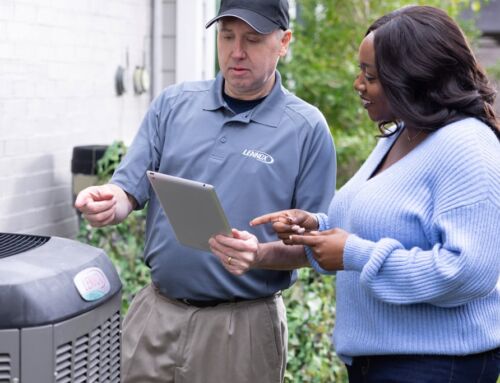Your home’s HVAC system can seem a little mysterious, but there’s no reason to be intimidated. Knowing about the heating and cooling system in your home is critical to being able to effectively operate and maintain it. That’s important, because the better you take care of your HVAC system—the more likely it is to be reliable and energy efficient.
Here are 10 of the most common HVAC questions and answers:
1. What Does HVAC Stand For?
HVAC stands for Heating, Ventilation and Air Conditioning. It refers to the equipment used for indoor comfort in homes, businesses and other buildings, including temperature control, ventilation and air quality regulation.
2. How Long Does a Furnace/AC Last?
The average life span of a furnace or air conditioning system is around 15 to 20 years. However, the actual longevity will depend on factors such as maintenance, usage and the type or brand of the system.
Regular tune-ups and timely repair, when necessary, can help ensure the optimal performance and longevity of your HVAC system.
3. How Much Does an HVAC System Cost?
The average cost of a home HVAC system averages between $3,000 to $10,000 for the system, plus installation. The cost will vary depending on various factors, such as the size of the system, installation complexity and additional features.
Arctic Circle Air works hard to make AC or furnace replacement as affordable as possible, providing special offers and financing for those who qualify. We offer a lineup of heating and cooling systems to fit a variety of budgets and make furnace or air conditioner installation easy on your wallet.
4. What Size Air Conditioner/Furnace Do I Need?
The size of air conditioning or furnace system that you need depends on several factors, such as the size and layout of your home. It’s important to choose a system that’s the right fit, because one that isn’t powerful enough could struggle to keep your home comfortable and one that’s too big could be inefficient and wasteful.
That’s why it’s important to work with professionals such as the team at Arctic Circle Air for air conditioning replacement or furnace installation. We will evaluate your home—paying close attention to the number of windows, square footage, layout, etc.—as well as examine other factors that will impact which size of HVAC system you need.
5. What HVAC System Qualifies for Tax Credits in 2023?
You may have heard that tax credits are available for HVAC systems. It’s true! To reduce emissions and increase sustainability, the federal government is offering HVAC tax credits or rebates to incentivize the purchase of energy-efficient systems.
The 2023 HVAC tax credits mostly apply only to energy-efficient products. The exact requirements vary between different kinds of equipment and from region to region. You can browse the full list here.
6. What Does SEER Mean in HVAC?
In the HVAC industry, SEER stands for Seasonal Energy Efficiency Ratio and measures the energy efficiency of air conditioning units. The SEER rating indicates the ratio of cooling capacity to power input, which shows how efficiently an air conditioner can convert electricity into cooling comfort.
However, starting on January 1, 2023, SEER was replaced by an updated version called SEER2. Designed to be a more accurate measurement, SEER2 indicates the same thing to consumers as the original SEER rating system—it is an indication of the energy efficiency of cooling systems.
7. How Often to Change an Air Filter?
Regularly changing the air filter ensures optimal airflow, improves indoor air quality, and helps maintain the efficiency and longevity of your HVAC system.
How often you should change the air filter on your furnace or air conditioner depends on several factors, including the type of filter, your home’s indoor air quality and usage patterns. As a general guideline, it is recommended to check a standard 1-inch filter monthly. If it looks dirty, change it. Otherwise, it’s good to change the air filter on your HVAC system about every 90 days.
However, households with pets, smokers, or individuals with allergies may need to change furnace or AC air filters more frequently.
8. How Often Should I Get HVAC Service?
To ensure the optimal performance and longevity of your HVAC system, it is recommended to schedule regular furnace and air conditioning maintenance at least once a year.
By having a professional inspect, clean and service your HVAC system annually, you can identify and address any potential issues before they become major problems. Additionally, regular AC and furnace maintenance helps improve energy efficiency, reduces the risk of breakdowns and extends the life span of your equipment.
9. How to Reduce Energy Bill?
Reducing your energy bill with your HVAC system can help you save money while also being more environmentally friendly. Here are three easy ways to lower your monthly power bill:
Set the temperature wisely: Adjust your thermostat to a comfortable yet energy-efficient temperature. For winter, the US Department of Energy recommends a temperature of 68-70 for maximum efficiency. Utilizing programmable or smart thermostats can help automate this process.
Ensure proper insulation: Make sure your home is well-insulated to prevent air leaks and minimize heat transfer. Insulating walls, attics and crawl spaces can help maintain a consistent indoor temperature and reduce strain on your HVAC system.
Upgrade to energy-efficient equipment: Consider upgrading to energy-efficient HVAC equipment, such as units with high SEER ratings or ENERGY STAR certifications. These systems are designed to use less energy to heat and cool your home.
10. How to Improve Indoor Air Quality?
Improving indoor air quality in your home is essential for maintaining a healthy and comfortable living environment. Contacting experts like the team at Arctic Circle Air for our indoor air quality services is a great way to start, but here are some additional steps to better the air quality in your home:
- Keep your home clean: Regularly dust, vacuum and mop to remove allergens, dust mites and pollutants that can gather on surfaces.
- Ventilate properly: Open windows and use exhaust fans in kitchens and bathrooms so fresh air can circulate and expel stale air.
- Control humidity levels: Use dehumidifiers in damp areas to prevent mold growth. Maintaining proper humidity levels (around 30-50%) also discourages the proliferation of allergens.
- Install air purifiers: Consider investing in air purifiers such as the Reme HALO to capture airborne particles like pollen, pet dander and mold spores.
- Regularly maintain HVAC systems: Change air filters regularly and schedule routine furnace and AC maintenance to ensure efficient operation and clean air circulation. Joining an HVAC maintenance plan is a great way to make this simple and easy.

